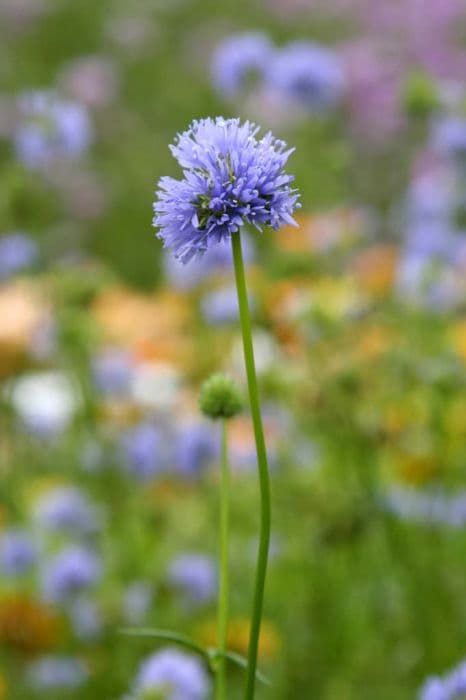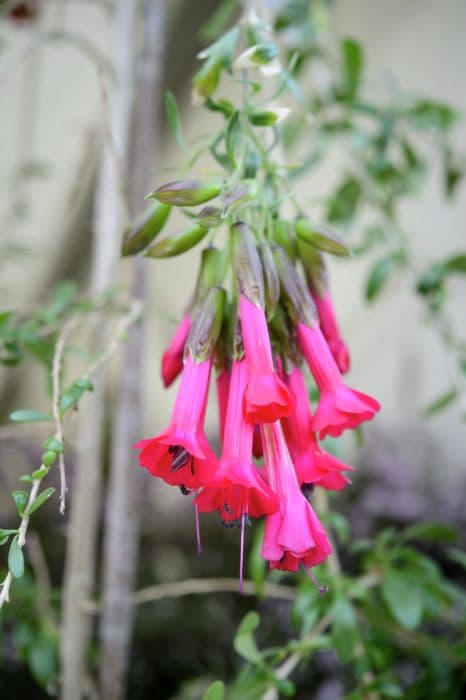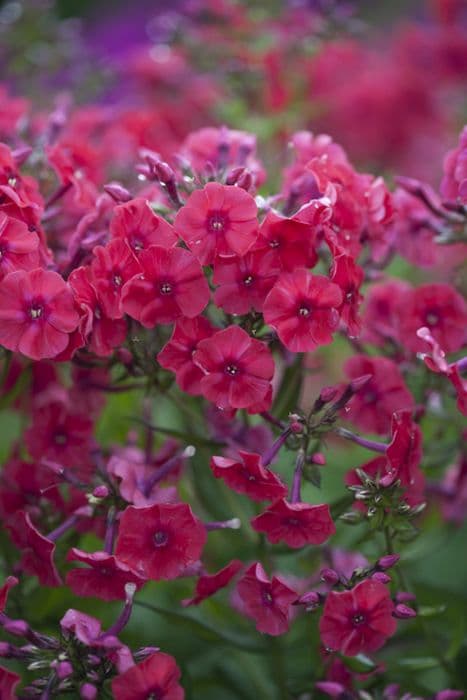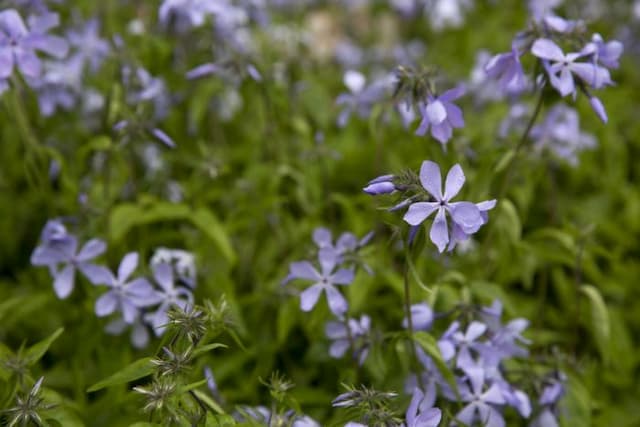Garden Phlox Phlox 'Kelly's Eye'

ABOUT
Phlox 'Kelly's Eye' is a captivating perennial plant known for its vibrant and showy blooms. The flowers are the standout feature of this cultivar, displaying a rich, intense color palette with a fiery mix of red and pink hues that draw the eye and enliven the garden. Each individual flower exhibits a classic phlox shape, typically composed of five, rounded, overlapping petals that together form a fetching, flat-faced bloom. In the center of the flowers, you can often find a deeper, contrasting tone or eye, which lends 'Kelly's Eye' its distinctive name and adds to its arresting appearance. The blooms are clustered together at the tops of the stems, creating dense, rounded heads of color that appear as bright, cheerful bouquets nestled among the foliage. These flower clusters make Phlox 'Kelly's Eye' a great choice for a statement piece in garden beds or borders. The leaves are an attractive deep green, providing a lush backdrop for the striking floral display. They are typically lance-shaped, offering a textural contrast to the softness of the petals. As the blooms progress, you might observe butterflies and hummingbirds being attracted to these flowers, thanks to their sweet nectar. With a dense and bushy growth habit, not mentioning its size, Phlox 'Kelly's Eye' can fill up space in the garden with its brilliant colors and fresh green foliage, presenting a spectacle of beauty that is hard to ignore when it is in full bloom.
About this plant
 Names
NamesFamily
Polemoniaceae
Synonyms
Garden Phlox, Summer Phlox
Common names
Phlox paniculata 'Kelly's Eye'
 Toxicity
ToxicityTo humans
Generally, Phlox is not known to be toxic to humans. However, it's always possible that some individuals may experience allergic reactions or sensitivity when handling plants or ingesting plant material that they are not familiar with. Typically, Phlox does not contain toxic substances that would lead to serious poisoning if ingested. If someone were to eat parts of a Phlox plant, they might experience mild gastrointestinal discomfort, including nausea or an upset stomach. If any severe reaction occurs, it's important to seek medical attention promptly.
To pets
Phlox is also not commonly known to be toxic to pets. Similar to humans, pets may have individual sensitivities or allergic reactions to plants, including Phlox. If a pet ingests a large quantity of Phlox, they might experience mild stomach upset, including symptoms such as vomiting or diarrhea. It's always good practice to keep an eye on pets and prevent them from eating garden plants, as individual reactions can vary. If you suspect your pet is experiencing more than mild discomfort after ingesting Phlox, consult with a veterinarian.
 Characteristics
CharacteristicsLife cycle
Perennials
Foliage type
Deciduous
Color of leaves
Green
Flower color
Purple
Height
2 feet 0.61 meters
Spread
2 feet 0.61 meters
Plant type
Herb
Hardiness zones
4
Native area
North America
Benefits
 General Benefits
General Benefits- Attracts pollinators: Phlox 'Kelly's Eye' is known for its ability to attract bees, butterflies, and other pollinating insects, which can help pollinate other plants in your garden.
- Low maintenance: It typically requires minimal care once established, making it a good choice for gardeners of all levels.
- Colorful blooms: This variety of phlox offers vibrant, colorful flowers that can brighten up any garden space.
- Drought tolerance: After getting established, it has a good tolerance for drought conditions, reducing the need for frequent watering.
- Rabbit resistant: Phlox 'Kelly's Eye' has a degree of resistance to rabbits, which can help reduce damage to the plant in areas where rabbits are a common nuisance.
- Fragrance: The flowers of Phlox 'Kelly's Eye' have a pleasant fragrance, adding an olfactory element to the garden experience.
- Long blooming period: It has a relatively long flowering period, which ensures colorful displays for a longer duration in the growing season.
- Versatile use in landscaping: It can be used in a variety of ways in landscapes, such as in borders, beds, and as ground cover.
 Medical Properties
Medical PropertiesThis plant is not used for medical purposes.
 Air-purifying Qualities
Air-purifying QualitiesThis plant is not specifically known for air purifying qualities.
 Other Uses
Other Uses- Phlox can be used in natural dye production, with various parts of the plant producing different hues depending on the mordant used.
- Its dried petals can be incorporated into potpourris for a subtle, sweet scent that can freshen up drawers and closets.
- Phlox flowers can be pressed and used in crafting, such as making bookmarks, greeting cards, or in scrapbooking for their aesthetic appeal.
- The plant can serve as a living mulch, providing ground coverage that helps retain soil moisture and suppress weeds.
- Phlox can be used in companion planting strategies to attract beneficial insects that prey on garden pests.
- Some gardeners use the phlox as an indicator plant for the presence of mildew, which can affect other garden plants.
- Floral designers may use phlox for its structural properties in creating naturalistic arrangements and bouquets.
- Phlox plants can be a part of sensory gardens, with their bright colors and fragrance providing visual and olfactory stimulation.
- The extensive root system of phlox makes it useful for erosion control on slopes or areas prone to soil degradation.
- Stems of phlox can be used in homemade wreaths and other decorative items for a rustic aesthetic.
Interesting Facts
 Feng Shui
Feng ShuiPhlox is not used in Feng Shui practice.
 Zodiac Sign Compitability
Zodiac Sign CompitabilityPhlox is not used in astrology practice.
 Plant Symbolism
Plant Symbolism- Harmony and Unity: Phlox in general symbolizes harmony and the unity of hearts, making it a representation of sweet dreams and wishes coming together.
- Proposal: Due to its clusters of flowers and long blooming period, phlox is sometimes associated with the idea of a proposal or an offer of commitment in love.
- Agreement: Phlox can also signify mutual consent or an agreement in friendship or love relationships, possibly referring to its natural growth pattern where individual florets are united in a dense cluster.
 Water
WaterGarden phlox, including the variety 'Kelly's Eye', prefer evenly moist soil, so it's important to water them regularly especially during dry periods. Water once a week with about an inch of water, which roughly translates to 0.6 gallons per square yard of soil. During hot, dry spells, watering may be needed twice a week. It's best to water garden phlox in the morning to allow foliage to dry out during the day, reducing the risk of fungal diseases. Avoid overhead watering to keep the foliage dry and instead apply water directly to the soil around the base of the plant.
 Light
LightGarden phlox thrives best in full sun to partial shade. For optimal blooming, ensure the plant gets at least 6 hours of direct sunlight daily. An ideal spot would be one that receives morning sun and some afternoon shade, especially in regions with hot summers.
 Temperature
TemperatureGarden phlox does best in temperatures ranging from 60 to 90 degrees Fahrenheit. They are hardy and can survive minimum temperatures down to -30 degrees Fahrenheit, making them suitable for many temperate climatic zones. The ideal temperature range for this plant during its active growing months is between 65 and 75 degrees Fahrenheit.
 Pruning
PruningTo maintain health and encourage bushier growth and more blooms, garden phlox should be pruned annually. The best time to prune is in late winter or early spring, just before new growth begins. Deadheading, or removing spent flowers, will encourage the plant to produce new flowers. It's also recommended to cut back the foliage to the ground level in late autumn to help prevent disease and pest issues.
 Cleaning
CleaningAs needed
 Soil
SoilGarden Phlox, including the 'Kelly's Eye' variety, requires a well-draining soil mix rich in organic matter with a slightly acidic to neutral pH of 6.5 to 7.0. A good soil recipe would be a blend of loam, compost, and perlite or coarse sand to ensure proper drainage and fertility. Proper soil composition is vital for the health and vibrant blooms of Phlox.
 Repotting
RepottingGarden Phlox, like 'Kelly's Eye', typically does not need frequent repotting as they are mostly grown as perennial plants in the garden. Repotting is generally performed when the plant outgrows its current location, which might be every few years. When planted in containers, they should be repotted every 2 to 3 years to refresh the soil.
 Humidity & Misting
Humidity & MistingGarden Phlox, such as Phlox 'Kelly's Eye', fares well in average humidity levels that are typically found outdoors. They do not require any special humidity conditions and can adapt to the natural humidity found in their growing environment.
 Suitable locations
Suitable locationsIndoor
Provide bright light and ensure good air circulation for indoor Phlox.
Outdoor
Plant in a sunny spot with well-draining soil and space for air flow.
Hardiness zone
4-8 USDA
 Life cycle
Life cyclePhlox 'Kelly's Eye', commonly known as Garden Phlox, begins its life cycle as a seed, which upon finding the right conditions—moist soil and warmth—germinates and sends out roots and shoots. The seedling emerges and establishes itself, growing into a vegetative state where leaves and stems are produced; during this phase, the plant focuses on accumulating resources and increasing in size. As it matures, Garden Phlox enters the flowering stage, where buds develop and bloom into clusters of fragrant flowers typically in shades of pink, red, purple, or white during late spring to early fall. After pollination, which is often aided by butterflies and bees, the flowers will produce seeds, completing the reproductive cycle. Once seed development is complete, the plant may enter a period of dormancy, especially in regions with cold winters, where it dies back to the ground and conserves energy in its root system. With the return of favorable conditions, Garden Phlox will resprout from its roots, beginning the cycle anew.
 Propogation
PropogationPropogation time
Spring-Early Summer
Phlox 'Kelly's Eye', commonly known as garden phlox, is typically propagated through stem cuttings. The ideal time to take cuttings for propagation is in late spring or early summer when the plant is growing vigorously. To propagate garden phlox by stem cuttings, one should select a healthy, non-flowering stem and cut a 4 to 6-inch (10 to 15 centimeters) length, making sure to include several sets of leaves. The bottom set of leaves is removed, and the cut end can be dipped in rooting hormone to encourage root development. The cutting is then planted in a moist potting mix, with the remaining leaves above the soil surface. Providing a high humidity environment can promote rooting, and roots typically develop within a few weeks. Once the cuttings have rooted and show signs of new growth, they can be transplanted to a more permanent location.









